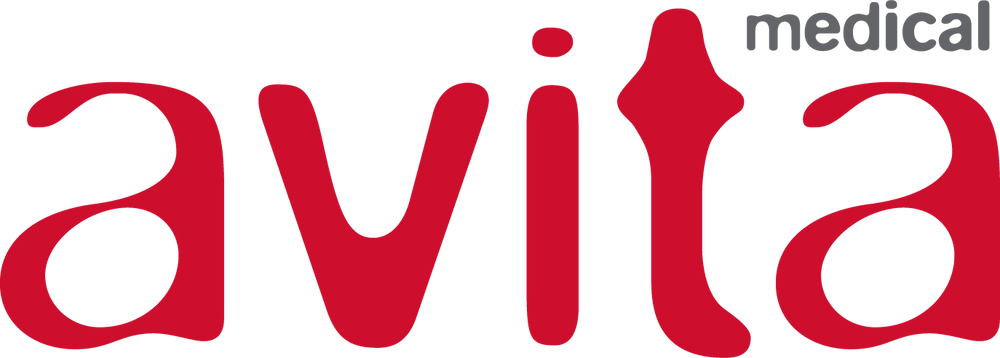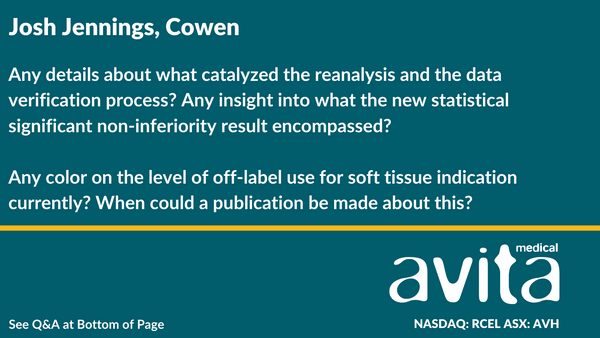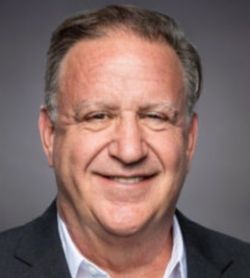
Good afternoon everyone, and thank you for joining us today. Before I express how excited I am to be here, I want to take a moment to thank and recognize Dr. Mike Perry. Mike served as CEO for the past five years, and we are grateful to him for his important contributions during his tenure.
I’m often asked what about AVITA Medical® attracted me to come and join the team? As an AVITA Medical board member for the past 5 quarters, I have become very familiar with the business and its challenges and opportunities. What I saw was a transformative technology that has already brought hope to thousands of patients, and an opportunity to work with a great team to bring this technology to thousands more.
To illustrate that, I’d like to share with you a recent patient journey, which has inspired me and the team at AVITA Medical. Charlie Anne Xavier was working on a project at her family’s brewery in Virginia when a life changing accident engulfed her in flames, causing third-degree burns to over 85-percent of her body. At the VCU Evan-Haynes Burn Center in Richmond, she was given a slim chance of survival, with the expectation of a 12-month stay in the ICU. Instead, Charlie Anne left the hospital nine days shy of six months, to which her husband credits RECELL® as a significant part of her successful recovery. Charlie Anne and her adoring husband, Andre, are now focused on giving back, by providing hope to anyone suffering from a traumatic burn injury. Thank you, Charlie Anne and Andre, for sharing your story of tragedy and triumph with us. This is the kind of life-changing impact RECELL continues to provide other patients and one of the many reasons I’m thrilled to have the opportunity to join AVITA Medical.
This story and others we have relayed truly demonstrate the importance of our burn work.

Now, I’d like to take a moment and discuss the initial priorities that I have been focusing on during my first 100 days as CEO.
First, developing the commercial plans for Burns and Soft Tissue Repair to drive our growth and preparing to execute on this plan.
Secondly, the FDA submissions for Soft Tissue Repair and Vitiligo are expected during December 2022, with approvals expected in June of 2023. Just last week the FDA informed us that the RECELL System has been granted the Breakthrough Device designation for both the soft tissue repair submission and the vitiligo submission. The Breakthrough Devices Program facilitates active interaction with the FDA and prioritizes the review of subsequent regulatory submissions, including our submissions expected in December.
Finally, the automation of the RECELL device for the soft tissue repair and burns program, which will be followed by an automated device for vitiligo.
Our growth for the next 24 to 36 months will be driven by the burns and soft tissue repair markets. The soft tissue repair market will expand our hospital call point and treating physician call points by nearly three times. This expansion of market opportunity is the foremost commercial priority of the company.
The vitiligo program will be focusing on achieving reimbursement, supporting early commercial cases, and clinical development in support of those initiatives, which we believe we will accomplish by Q1 2025.

We had strong top line revenue performance with 9.0 million dollars in commercial revenue in Q3 2022, which is a 30-percent increase over the same period the prior year; and a 9-percent increase on a consecutive quarter basis. Keep in mind that commercial revenue includes all global revenue, and excludes the 0.1 million in BARDA revenue booked in the quarter.
I also have a Japanese market update. In early September, the Ministry of Health, Labor, and Welfare (commonly known as MHLW) granted the RECELL System marketing approval for the treatment of acute burns in Japan with very favorable reimbursement of ¥970,000 for our standard device, which is approximately $7,000 converted at the current exchange rate. We of course share that revenue with COSMOTEC. The end-customer reimbursement price is slightly higher than our current pricing in the U.S., of which AVITA Medical receives 40-percent from our partner, COSMOTEC.
COSMOTEC is preparing to launch RECELL and we have received an initial stocking order of 555 thousand dollars from COSMOTEC in September. As a point of note, other than U.S. revenue, we do not intend to release country-specific revenues in the future, unless there is some unusual event that causes us to do so.
Let me provide an update on our Ease-of-Use product. We started selling the ease-of-use device in Q1 to our larger accounts, which has been well received by our customers. One of the reasons customers prefer this version of RECELL is that it streamlines the workflow, mitigates the staffing shortage, and reduces the training efforts that both the customer and the AVITA Medical team need to perform. We plan to expand the availability of our ease-of-use product in the upcoming quarters.
With regard to the soft tissue repair market, we are prioritizing our soft tissue repair launch given our existing codes, the overlap with level 1 and 2 trauma centers and our existing burn center customer base, and ability to leverage and expand our current sales force.
One clear upside in prioritizing soft tissue repair is that we will have immediate reimbursement. While burns are primarily in-patient reimbursement, we also have out-patient reimbursement through our transitional pass-through code. With the soft tissue repair indication, we find the majority of patients in level 1 and 2 trauma centers being treated in the out-patient setting. Thus, we have been educating our burn customers on how to utilize these codes correctly. Further, approximately 50-percent of our current burn centers overlap into level 1 and 2 trauma centers. Thus, we will gain significant leverage from the sales organization as we expand in the coming year.
Earlier this year, we released the topline results for our soft tissue repair trial. The study had two co-primary endpoints: one endpoint had a hypothesis of superiority for donor skin sparing and the other co-primary endpoint had a hypothesis of non-inferiority for healing, based on pairwise comparisons where each subject received both RECELL treatment and standard of care treatment as the study Control.
I am pleased to report that both co-primary endpoints have been met for both donor sparing superiority and non-inferior healing for RECELL in soft tissue repair. In our initial analysis, the healing endpoint for RECELL versus Control did not reach pre-specified statistical non-inferiority, however, after data re-verification and associated corrections, an updated analysis has revealed that the healing endpoint has been met.

For those of you who might be new to AVITA Medical, vitiligo is a chronic autoimmune disease that attacks pigment producing cells, resulting in spots or patches of lighter or white depigmented skin. Although not life-threatening, it can occur anywhere on the body and can result in severe psychological debilitations due to perceived disfigurement. Today, Vitiligo affects up to two-percent of the population worldwide, including an estimated 6.5 million Americans.
In September, we announced results from a pivotal clinical trial evaluating the safety and effectiveness of the RECELL System for repigmentation of stable vitiligo lesions. We met our primary endpoint in this trial. Let me share a little bit about that endpoint. It is unique as there has never been a trial that effectively treats vitiligo with cellular transplantation.
The study compared success rates, in a design where each patient randomly received RECELL treatment in one portion of the depigmented area.
The study control treatment was the standard of care narrowband ultraviolet-B phototherapy, which is typical first-line treatment for vitiligo. Repigmentation was evaluated six months after treatment by an expert central review committee (CRC).
- The CRC reported 56% of RECELL treatments (versus 12% of control treatments) resulted in repigmentation of more than 50% of the treated area
- The CRC also reported 36% of RECELL treatments (versus 0% of control treatments) resulted in repigmentation of at least 80% of the treated area, establishing super superiority for the primary endpoint. (p<.025).
We have had an opportunity to review this data with our medical advisors. Their response was enthusiastic, particularly, because they have no treatment that achieves this result in six months. These are the first results from a U.S. randomized, controlled trial of the RECELL System in treating patients with segmental and nonsegmental stable vitiligo, and provide a foundation for communicating favorable clinical benefit. We intend to submit to the FDA for this indication in December of this year, with approval expected in June 2023.
We are tremendously excited about the pending submission and subsequent approval in June 2023. Going forward, we will be working with private payers and CMS to establish reimbursement for the vitiligo RECELL treatment. Currently, we believe we can achieve this by January 2025. During the interim period, we will continue to conduct vitiligo clinical research to support the ideal patient selection and treatment regimen for the broader population of vitiligo patients. The pure scale of the market and the significant benefit to these patients will be further enhanced by our automation program, which will allow for physician office treatment with the RECELL for vitiligo. We will keep you current with our progress on automation, clinical development, and reimbursement.

First and foremost, we are focused on accelerating growth in our burns business through greater penetration in burn centers and greater adoption by burn surgeons, and the expansion of our commercial organization.
Second, we are planning a full and immediate launch into the soft tissue repair market in July 2023 following the expected FDA approval in June 2023. We plan to hit the ground running at launch with an expanded field force in place as well as with commercial support resources and programs.
Looking at this strategically, our growth in 2023 and 2024 will be driven by the penetration of the burn and soft tissue repair markets in the U.S. followed by the achievement of reimbursement for vitiligo for a full launch in January 2025.

Our commercial revenue, which excludes BARDA revenue, increased by 30% or $2.1 million to $9.0 million in the three months ended September 30, 2022, compared to $6.9 million in the corresponding period in the prior year. Total revenue, which includes BARDA revenue, increased 30% or $2.1 to $9.1 million compared to $7.0 million. The growth in commercial revenues was largely driven by deeper penetration within individual customer accounts along with the commencement of commercial sales with our partner COSMOTEC in Japan.
Gross profit margin decreased by 2% to 83% compared to the corresponding period in the prior year.
Total operating expenses increased by 16% or $2.0 million to $14.2 million compared to $12.3 million in the corresponding period in the prior year. The increase in operating expenses is attributable to higher compensation costs, pre-commercialization costs, research and development expenses, partially offset by lower share-based compensation expenses. Higher compensation costs were primarily a result of an expansion of our commercial team along with an increase in commissions which resulted from an increase in commercial revenues. In addition, we incurred severance costs in the current quarter associated with the termination of a former executive employee. Higher pre-commercialization costs are driven by activities related to future RECELL launches in soft tissue repair and vitiligo. Increased research and development expenses resulted from ongoing development of next generation devices for more automated preparation of Spray-On Skin Cells. Higher research and development expenses were partially offset by lower clinical trial expenses for soft tissue repair and vitiligo as trial participants were in less costly follow-up phases this period compared to more costly recruitment and treatment phases in the prior period. Share-based compensation expense was lower in the current period as certain performance milestones were met in the prior period, and there was a reversal in the current period of previously recognized expense for unvested awards related to the termination of an executive officer.
Net loss decreased by 6% or $0.4 million to $5.6 million, or $0.22 per share, compared to a net loss of $5.9 million, or $0.24 per share, in the corresponding period of the prior year.
Adjusted EBITDA* loss increased by 2% or $84 thousand to $4.0 million, compared to a loss of $3.9 million in the corresponding period in the prior year. A table reconciling non-GAAP measures is included in the related press release for reference.
Turning to guidance, full year 2022 commercial revenue guidance is revised and increased to a range of $33-34.0 million, excluding BARDA revenues, which represents an approximate 33% increase year-over-year. We continue to project BARDA revenues of approximately $0.3 million in calendar year 2022.

1.Charlie Montang, Lake Street Capital
How do the Fast Track designations change the way you approach soft tissue and vitiligo?
Jim Corbett
The principal contribution that the designation gives us is, it causes for essentially a very dynamic and real time review process within a prioritization with FDA that is the number one benefit that we’ll enjoy with both submissions of soft tissue and vitiligo. It also will help us later as we develop reimbursement for vitiligo. So those are the two principal benefits of that designation.
Charlie Montang
Has the hospital environment returned to normal? And if it’s not, where are we and where do you think or do you see the hospital environment over this winter?
Jim Corbett
Well, overall the hospital environment returned to a place where we have good access in terms of our selling time, and very good access in terms of our support of physicians and their staff in terms of training, as well as supporting cases. So we actually are not heavily impacted by the hospital environment, we do see that there’s some staffing shortages, which causes us to have to do a little bit more training with the staff and that uses of course selling time to do that. But I wouldn’t characterize it as a dominant or significant challenge for us in the current time as we see it.
2. Matthew O’Brien, Piper Sandler
So I just want to make sure we tease out what you’re getting from Japan versus the increase in guidance here? I think you said, $555,000 here in Q3? Are you going to get some more from COSMOTEC in Q4 as far as a bulk order? And then, I guess just to kind of wrap up the question. If it’s – I don’t know $1 million, then you have a $2.5 million increase in the guide… So clearly the fundamentals are picking up. Can you just talk about you know what that is from in terms of share taking –penetration of existing accounts versus new accounts that you’re onboarding?
Jim Corbett
With respect to Japan, the initial stocking was $555,000. We do not yet have a clear view on this case of the launch, although there were quite a number of cases performed in the last 30 days. So we know that they’re active and they’re consuming that initial stocking order. We’re expecting that during the next quarter, we’ll get some visibility in the coming year. And when we get that, we’re going to communicate that to you and the rest of the market.
In terms of our core business, we didn’t add very many new accounts, because we’re in some markets up to somewhere between 140, 150 burn centers in the United States. So our uptick in revenue is reflective of increased penetration. So we are going to increase penetration and a broader use by surgeons. So we expect that to continue, as part of our soft tissue repair initiative over the next six months we will be increasing the coverage profile of our sales force where they have time to be deeper in the accounts, which is where the action is.
Matthew O’Brien
But just to be clear, only $500,000 of the $3.5 million increase for the year is from Japan? So the $3 million is domestic?
Jim Corbett
That’s correct. $555,000.
Matthew O’Brien
I don’t want to get into vitiligo too much, because you’ve got a lot of opportunity on the burn and soft tissue side. But I just want to make sure that the message is clear here, you’re still very bullish on the vitiligo, I don’t want to put words in your mouth, but it seems like you’re still very bullish on the opportunity, but just given your resources and the opportunity for soft tissue plus burn, the focus now do a lot more work to get reimbursement in place and have another growth driver of a big market in ‘25 and in the back half of the decade, is that the right way to view it?
Jim Corbett
When you look at vitiligo, our results have been just received fantastically, enthusiastically by our medical advisors – that there is no such treatment for these patients that achieves the results that we achieved in our trial. So we’re extremely bullish on it. That said, we need to get reimbursement sorted out. And that will take a little bit of time. We estimate right now that in January ‘25 our plan looks as though that it will be when we succeed at that. And that will, of course, drive ‘25 forward with vitiligo. Between now and then and inclusive of ‘25, the penetration of burns, and soft tissue repair really drive our growth. And we’ll be investing in the organization to be able to take advantage of that opportunity. So I think you are exactly right.
3. Ryan Zimmerman, BTIG
Wanted to ask about the domestic burn dynamics a little bit. It was really encouraging to see. Wondered if you can elaborate and maybe if Erin is on the call as well, just around you know the interest and usage of RECELL from a TBSA perspective this quarter you know just given what we’ve seen with other players in the space, who maybe had softer results. I’m just curious if you feel like you’re taking some share from maybe some of the larger burn cases that are out there?
Jim Corbett
We didn’t see a downtick in burns’ admissions during the quarter. And we did see the results of some other participants in the market. It’s not our assessment, therefore, that we aren’t taking share you know in the TBSA different categories. So the dynamic doesn’t seem to have meaningfully changed from our view. So it has to be there therefore a share gain.
Ryan Zimmerman
As you think about the investment that you need to make in soft tissue, in both the kind of the near-term and medium-term, can you elaborate a little bit more specifically– given that it is 3x, the opportunity. I don’t know if that implies maybe 3x, the field force, but I’d be curious to get some color about how you’re thinking about ramping that commercial strategy, be it feet on the street or just you know broader investments and how we should be thinking about it from a modeling perspective?
Jim Corbett
I’ll answer on a rather high level, I think in our February conference call, I’ll be able to give it to you in some detail. But quite simply, the market overlaps in the following manner, Level 1 and 2 trauma centers are the soft tissue repair target. They overlap about 50% with our burn centers. So we’ll have a need to invest in an organization that can reach those additional level 1 and 2 trauma centers. And we’ll be doing that actually during the first half of next year ahead of the anticipated approval in June.
So given that we have reimbursement already, both inpatient DRG and also outpatient, we intend to be in a position to take advantage of that reimbursement immediately in July of next year, pending that approval by FDA. So that is how we’re thinking about it. We’re in the midst of planning it right now. We’re finalizing our plans in the next 30 days and begin executing on that. I think when we’re on the February call, I’ll have some further detail for you.
4. Joshua Jennings, Cowen
I was hoping to just ask about the data verification reanalysis of the primary endpoint for the soft tissue trial. Just any other details you can share about what catalyzed the reanalysis and the data verification process? Is this standard fair? And then any help just interpreting what the new statistical significant non-inferiority result encompassed?
Jim Corbett
If you recall, our initial top line readout was really quite good on its own, notwithstanding, it didn’t meet the predetermined endpoint. We did what you always do in this type of study, you do a 100% review of the source endpoint data against the clinical database to make sure that when you submit, you have it right and subject to an FDA examination of the same data you don’t want to have any errors.
During the process two subjects were updated. One had a data entry error and one subject should have been excluded from the analysis as they had surgery to remove a medication implant that was right in the RECELL wound and interfered with the healing. So that is really just those two patients and it was really part of the standard source endpoint data review.
Joshua Jennings
Thinking about the soft tissue opportunity in front of approval, I understand there is some off-label you now have data that supports the indication, but just not a regulatory approval. How – any help just thinking about the level of off-label use for soft tissue indication currently? And when a publication could be made, that could tell us more off-label use even in the front of that July launch timeframe that you’ve provided?
Jim Corbett
Yeah, really great question. So, first of all, of course, we won’t be promoting off-label during that time frame. One of the benefits, though we get from an early preparation of the sales team is, there are burn cases that show up in Level 1 and 2 trauma centers that are not required to be treated in a burn center. So we’ll start getting some benefit from that during, I would estimate, Q2, and again, this is one of those things that I’ll be updating you with in the February conference call.
But I think that we’re going to be staying focused on getting prepared for that June expected approval and the launch in July that would follow. And in the meantime, we’ll be training our organization to get them ready, they’ll have the opportunity in those other centers to pick up some additional sales from the burn that enter Level 1 and Level 2 trauma centers. So, I think that’s the best characterization I can come to at this moment.
Joshua Jennings
Thinking about off-label use and you now have data set in stable vitiligo, there is a melanocyte, keratinocyte transplant procedure that’s being performed. I mean, do you suspect that some derms will want to get their hands on a RECELL System and start performing melanocyte transplant procedures with the RECELL System in front of approval or in front of reimbursement? Thanks a lot.
Jim Corbett
I don’t have an expectation that we’ll be promoting or placing RECELL in derm’s offices between now and approve, I don’t anticipate that. We do anticipate some cash pay post approval and we do anticipate supporting some clinical work, both investor – you know investor initiated as well as some work we’re going to do ourselves.
So, there will be activity in that respect, but not I don’t think we’ll be communicating a significant upward guidance as a consequence. So, I think we’ll see during the period before approval for soft tissue. Physicians can choose to use RECELL for a grafting need, but at the same time, it won’t be a consequence of our promotion.
5. Madeleine Williams, Wilsons
With RECELL and burns, you have been able to build out a pretty successful sales force and generate pretty good productivity there. I’m not sure if this was mentioned, but just wanting to understand what your expectations are for the sales force going forward, and then expanding that as soft tissue and potentially vitiligo down the line you know become commercial, understanding that I believe the sales force it’s around 30 at the moment?
Jim Corbett
So, the field force is around 30, which includes both field support for cases as well as direct salespeople. And so you’re approximately right in that particular number. The opportunity in soft tissue is as I mentioned, in the order of 3x, larger than that with burns, both in call points, hospitals and the market size. And so, to really get after that, it’s necessary to invest in a sales expansion that will at least cover the large volume centers throughout the United States, which we will be doing.
And as I mentioned earlier, I’ll characterize what I think in a little bit more detail in the call that we do in February. You’ll see the investment characterized at that time… our current early thinking is that we will be having that next investment become so to speak reality during the Q2 period. And we will provide some further guidance on that.
Jim Corbett
We’re really feeling very excited about the progress we made this quarter. And we’re looking forward further to our submissions for vitiligo and soft tissue here in December in the next month or so. So this is really setting the pace for our increased rate of growth that we expect in 2023 and ‘24. And I’m looking forward to sharing that with you in the February call. So thank you all for attending. And I look forward to speaking with you more at that time.
AVITA Medical is a regenerative medicine company leading the development and commercialization of devices and autologous cellular therapies for skin restoration. The RECELL® System technology platform, approved by the FDA for the treatment of acute thermal burns in both adults and children, harnesses the regenerative properties of a patient’s own skin to create Spray-On Skin™ cells. Delivered at the point-of-care, RECELL enables improved clinical outcomes and validated cost savings. RECELL is the catalyst of a new treatment paradigm and AVITA Medical is leveraging its proven and differentiated capabilities to develop first-in-class cellular therapies for multiple indications, including soft tissue repair and repigmentation of stable vitiligo lesions.
* Use of non-GAAP Measure
AVITA Medical’s reported earnings are prepared in accordance with generally accepted accounting principles in the United States, or GAAP, and represent earnings as reported to the Securities and Exchange Commission. AVITA Medical has provided in this release certain financial information that has not been prepared in accordance with GAAP. AVITA Medical’s management believes that the non-GAAP adjusted EBITDA described in the release, which includes adjustments for specific items that are generally not indicative of our core operations, provides additional information that is useful to investors in understanding AVITA Medical’s underlying performance, business and performance trends, and helps facilitate period-to-period comparisons and comparisons of its financial measures with other companies in AVITA Medical’s industry. However, the non-GAAP financial measures that AVITA Medical uses may differ from measures that other companies may use. Non-GAAP financial measures are not required to be uniformly applied, are not audited and should not be considered in isolation or as substitutes for results prepared in accordance with GAAP.
This press release includes forward-looking statements. These forward-looking statements generally can be identified by the use of words such as “anticipate,” “expect,” “intend,” “could,” “may,” “will,” “believe,” “estimate,” “look forward,” “forecast,” “goal,” “target,” “project,” “continue,” “outlook,” “guidance,” “future,” other words of similar meaning and the use of future dates. Forward-looking statements in this press release include, but are not limited to, statements concerning, among other things, our ongoing clinical trials and product development activities, regulatory approval of our products, the potential for future growth in our business, and our ability to achieve our key strategic, operational, and financial goal. Forward-looking statements by their nature address matters that are, to different degrees, uncertain. Each forward-looking statement contained in this press release is subject to risks and uncertainties that could cause actual results to differ materially from those expressed or implied by such statement. Applicable risks and uncertainties include, among others, the timing and realization of regulatory approvals of our products; physician acceptance, endorsement, and use of our products; failure to achieve the anticipated benefits from approval of our products; the effect of regulatory actions; product liability claims; risks associated with international operations and expansion; and other business effects, including the effects of industry, economic or political conditions outside of the company’s control. Investors should not place considerable reliance on the forward-looking statements contained in this press release. Investors are encouraged to read our publicly available filings for a discussion of these and other risks and uncertainties. The forward-looking statements in this press release speak only as of the date of this release, and we undertake no obligation to update or revise any of these statements.













